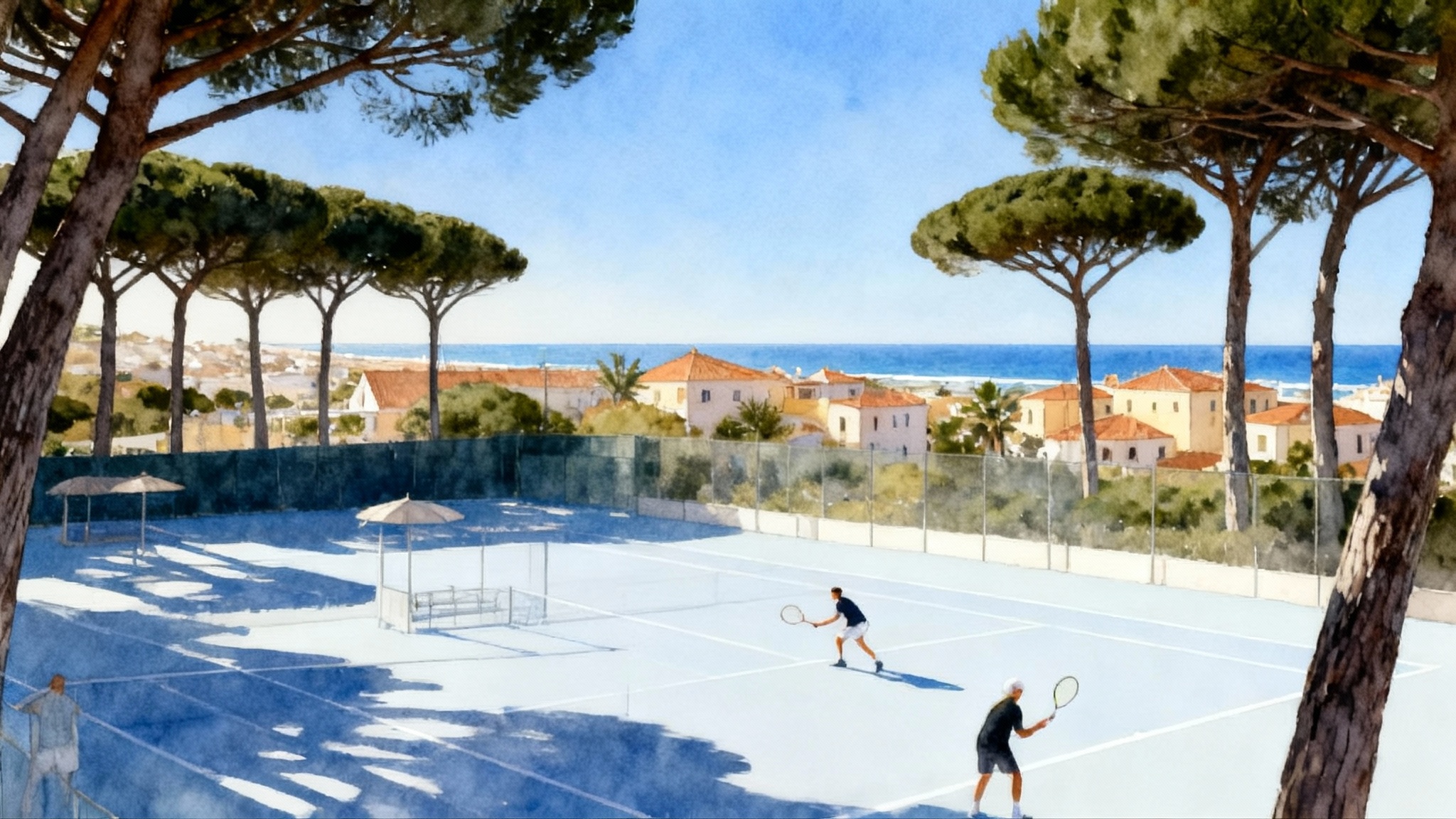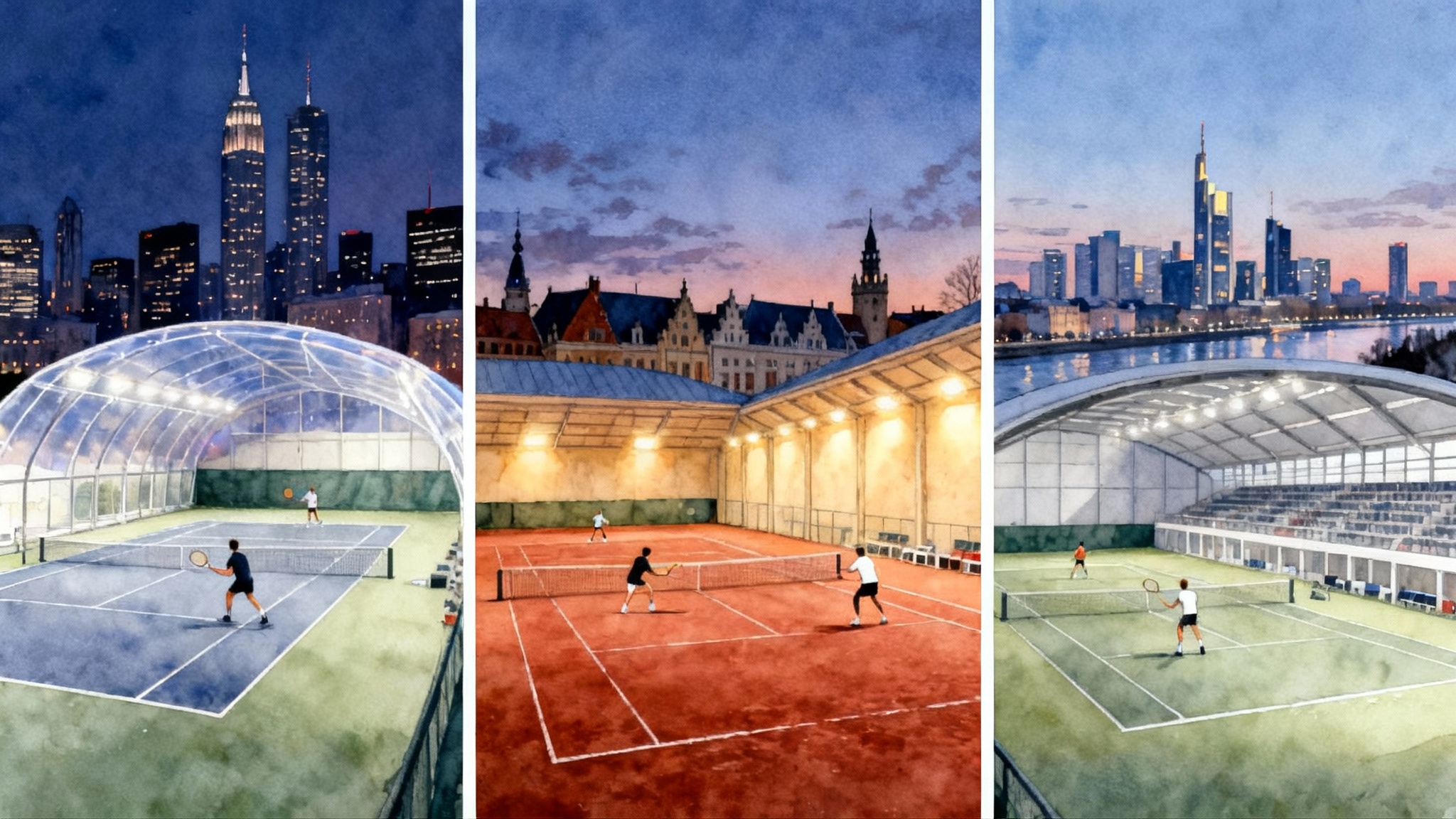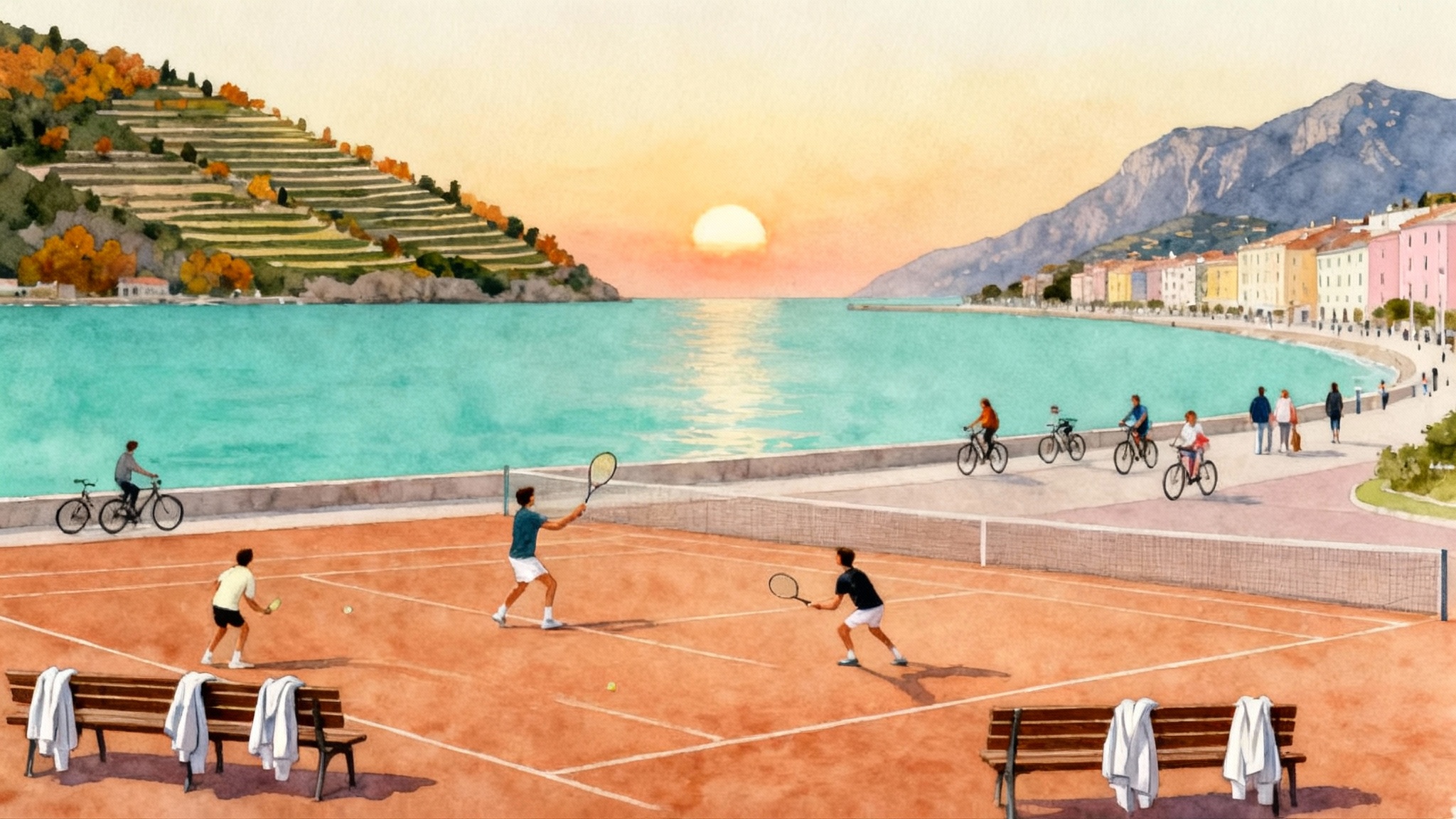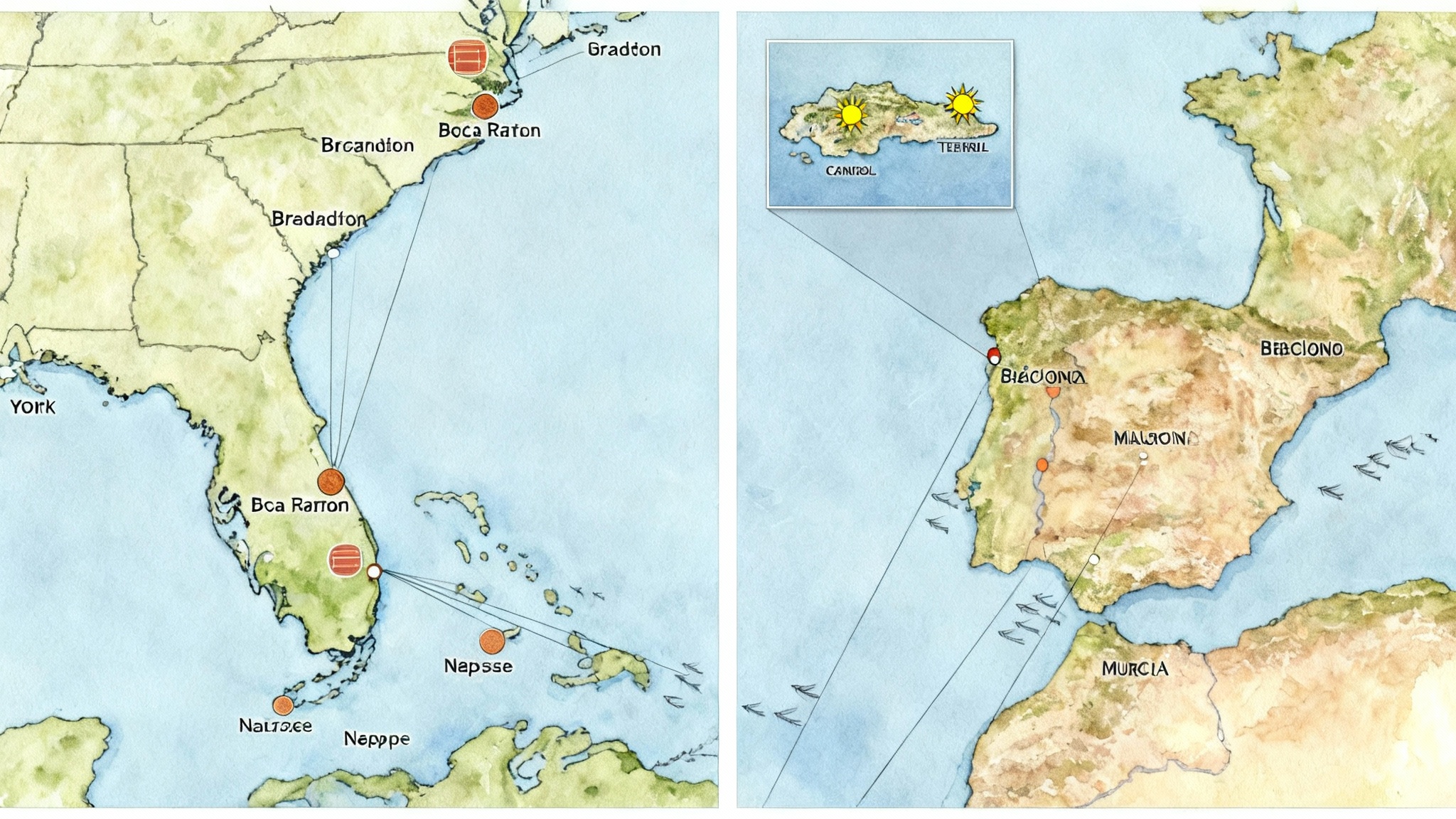Algarve Winter Guide: Europe’s Outdoor Tennis Base, Nov to March
When the rest of Europe heads indoors, the Algarve stays open for business. Use this guide to plan a November to March tennis escape with mild weather, clustered courts, smart coaching at Vale do Lobo, and easy flight and stay options.

Why the Algarve works November to March
If you want real outdoor tennis during a European winter, the Algarve is the reliable pick. The south of Portugal enjoys a dry, sunny microclimate that turns November to March into a training window rather than an off season. Average daytime highs sit in the mid to high teens Celsius (60 to 66°F), nights are cool rather than cold, and skies clear quickly after passing showers. The Serra de Monchique hills to the north help shield the coast from Atlantic weather, so you get more playable hours and fewer washouts than in most of Europe.
What this means on court: mornings are often calm and bright, mid days bring a light breeze, and late afternoons cool down just enough to keep balls lively without overheating players. Rain tends to arrive in short bursts, not all day. Courts dry quickly on sandy subsoil and maintenance teams are used to winter sessions, so a post‑shower squeegee is usually all it takes to get back out.
If you are weighing other winter bases, compare options in our Winter 2025 training map.
Wind and rain, translated for tennis
Weather talk is only useful when it becomes actionable. Here is the practical version for winter in the Algarve.
- Wind: expect light to moderate breezes, often from the north or west. The south coast sits in a lee, so wind is less punishing than on the Atlantic west coast. Morning sessions are the calmest. If the forecast shows a gusty afternoon, book a court with hedges or buildings upwind and warm up crosscourt to calibrate ball flight.
- Rain: November to January brings the most precipitation, but in concentrated bands. Plan one flexible hour in your weekly schedule for rescheduling. Clay and synthetic clay will need more time to dry than hard courts, so mix surfaces in your plan to keep options open.
- Temperature: dress in layers. A light mid layer for start of play, then a breathable shirt once the sun is up. Bring a second dry shirt for the second hour. Grip tackiness drops in cool, dry air; stash two fresh overgrips per session.
Where to play: the three clusters that matter
Think of the Algarve as three practical tennis maps. Pick one cluster, stay nearby, and stop burning time in the car.
Lagos and the western Algarve
- Vibe: coastal town with surf energy, historic streets, and a relaxed pace. Slightly more breeze than the central coast, which can be a positive for conditioning and for players who want to learn ball control in crosswinds.
- Courts and surfaces: a solid mix of acrylic hard courts, synthetic grass, and increasing availability of clay or clay‑like surfaces. Resorts and clubs in and around Lagos, Meia Praia, and Praia da Luz offer bookable courts plus on‑site coaching.
- Who it suits: adventurous adults, families who want tennis in the morning and beaches, hikes, or surf in the afternoon.
Albufeira and central Algarve
- Vibe: the geographic middle. Easy launch point to explore east or west. Plenty of restaurants open year round. A wide spread of clubs means good availability in winter.
- Courts and surfaces: acrylic hard courts are common, with pockets of clay and synthetic clay. Central location helps if you want to range to Vilamoura or Alvor for match play.
- Who it suits: groups that prioritize convenience and variety, and players seeking multiple weekly hitting partners.
Quinta do Lago, Vale do Lobo, and the Golden Triangle
- Vibe: polished resort zone with top golf, well kept estates, and a tight radius of sport facilities. If you want everything within ten minutes, this is it.
- Courts and surfaces: premium complexes with acrylic hard, synthetic clay, and adjacent padel courts. Lighting and wind breaks are common, which helps winter schedules.
- Who it suits: serious adult improvers, juniors on structured blocks, and mixed level groups who want guaranteed court quality.
Spotlight: Vale do Lobo Tennis Academy
The Vale do Lobo Tennis Academy is the structured coaching anchor many winter travelers want. The academy combines small group clinics, private sessions, and match play blocks so you can stack hours without guesswork. Coaches are used to short, focused stays; they will place you with appropriate hitting partners and adjust content on the fly.
What a typical week looks like at Vale do Lobo in winter
- Assessment and placement: a short hitting evaluation on day one sets drill intensity, tactical themes, and partner groups.
- Adult clinics: themed morning drills that target serve plus one patterns, neutral ball depth, and crosscourt discipline, followed by 60 minutes of live points and coached tiebreaks.
- Private lessons: one or two technical slots in the week with video capture and a simple action plan you can take home.
- Junior programs: age and level based squads focus on footwork patterns, serve mechanics, and competing with respect for routines. Winter weeks often include fitness circuits and match charting to build awareness.
- Add ons: cardio tennis for aerobic base, ball machine for repeatable reps, and padel for coordination without overloading the shoulder.
If you need a single base with proven structure, this academy removes the planning burden and keeps you accountable. Book clinics first, then layer in privates, then match play.
Surfaces and how to use them
- Acrylic hard: the most common in the Algarve. Reliable bounce and fast drying after rain. Good for repetition and serve pattern work. Rotate shoes to keep cushioning fresh if you hit more than two hours per day.
- Clay and synthetic clay: growing availability in resort clusters. Helps you rebuild sliding skills and point construction. Expect slightly longer drying time in winter. Bring a soft brush and a darker pair of socks.
- Synthetic grass: you will see it at many coastal resorts. Lower friction, skids on the first bounce, and rewards early preparation. Use it to train balance, compact swings, and low slice.
Sample training weeks you can actually follow
Adult improver, six day block
- Monday: 90 minute placement clinic, then 60 minutes of guided point play. Afternoon, 45 minutes of mobility and a brisk beach walk.
- Tuesday: 60 minute private lesson on the serve, 60 minute partner hitting focused on crosscourt depth ladders. Evening, cold plunge in the pool for ten breaths and an early night.
- Wednesday: 90 minute pattern clinic on return plus first ball, then 60 minutes of doubles drills. Light recovery jog or bike ride.
- Thursday: 60 minute private on backhand stability, 60 minute match play set with a similar level local. Stretch hips and calves for 15 minutes.
- Friday: 90 minute clinic on transition and finishing at net, optional 30 minute ball machine on approach footwork. Afternoon, padel for coordination and fun.
- Saturday: team tiebreak session, then 30 minutes of shadow swings with video on your phone for review. Afternoon off.
Junior performance, six day block
- Monday: technical intake with serve slow motion, 90 minute footwork and hand feed. Evening, homework on between point routines.
- Tuesday: 120 minute squad with patterns and live points, 30 minute fitness circuit of medicine ball throws, split step drills, and band work.
- Wednesday: match set against a local junior, chart two key metrics, for example first serve percentage and rally ball depth. Debrief with coach for 15 minutes.
- Thursday: 90 minute drilling on defense to offense, 30 minute conditioning with short hills. Refuel with a simple carbohydrate and protein snack.
- Friday: 120 minute squad with tiebreak ladder and pressure games, recovery stretch and contrast shower.
- Saturday: tournament style match play morning, film changeovers to review routines and emotion control. Afternoon, beach walk and full rest.
What it costs in winter
Prices vary by venue and month, but these ranges will help you budget.
- Court hire per hour: 12 to 25 euros for hard courts, 18 to 30 euros for clay or synthetic clay, lighting adds 3 to 6 euros per hour.
- Private coaching: 60 to 100 euros per 60 minutes depending on coach seniority and academy profile.
- Group clinics: 25 to 45 euros for 60 to 90 minutes in mixed level groups of four to six.
- Junior weekly squads: 200 to 450 euros for five to six sessions, higher for performance blocks with fitness and video.
- Equipment and extras: ball machine 15 to 25 euros per 30 minutes, restringing 18 to 30 euros, overgrips 2 to 4 euros each.
Accommodation in winter is friendly to tennis budgets.
- Apartments and aparthotels: 60 to 120 euros per night for one bedroom units near courts.
- Mid market hotels and resorts: 90 to 180 euros per night, breakfast included, often with heated pools and spa access.
- Villas and townhouses: 150 to 300 euros per night for two or three bedrooms, good for groups splitting costs.
Car hire in winter is usually 15 to 35 euros per day for a compact. Fuel is comparable to other Western European countries. The A22 motorway runs along the coast with electronic tolls; rentals typically provide a transponder and bill later. If you prefer not to pay tolls, the older National 125 road parallels the highway, but plan more time.
Getting there from the United States and Europe
- Fly to Faro Airport for the shortest transfer. Winter schedules still include frequent flights from major European hubs. From the airport, Quinta do Lago and Vale do Lobo are 20 to 25 minutes, Albufeira is 35 to 45 minutes, Lagos is 60 to 75 minutes.
- From the United States, connect via Lisbon, London, Madrid, Amsterdam, Frankfurt, or Paris. Total travel time commonly lands between 11 and 16 hours depending on layovers. If schedules do not line up, consider flying into Lisbon and driving south two and a half to three hours on the A2, or fly into Seville in Spain and cross the border to the Algarve in about two hours.
- Pack rackets in your cabin bag to avoid temperature swings in the hold. Put strings one to two kilograms tighter than your summer setup to account for cooler air, or carry an extra freshly strung frame.
Where to stay, by cluster and goal
Lagos
- Best for value and variety. Pick aparthotels near Meia Praia or Porto de Mós to cut drive time. Choose a property with laundry if you train daily. Look for heated pools or a simple sauna to help recovery on cooler days.
Albufeira
- Best for convenience and central access. Aim for properties near Balaia, Santa Eulália, or the Vilamoura side if you plan to mix tennis with golf. Many resorts keep tennis and padel open year round.
Quinta do Lago and Vale do Lobo
- Best for structured weeks and minimal logistics. You will pay a premium, but you gain walkable or short drive access to courts, gyms, pools, and sports medicine. Pick accommodation that includes spa or hydrotherapy access if you intend to train twice daily.
For shoulder season planning in Europe, see our guide to fall tennis on the Rivieras.
Lifestyle add ons that fit a training week
- Golf: the Algarve is a world class golf corridor. Quinta do Lago North, South, and Laranjal, Vale do Lobo Royal and Ocean, and the Vilamoura courses give you options within a short radius. Book twilight slots on light training days.
- Surf: on calm days, the south coast has mellow beach breaks for lessons. When you want more swell, the west coast near Sagres and beaches like Amado or Arrifana deliver. Pair surf days with lighter tennis to protect shoulders.
- Recovery and spas: many resorts offer heated pools, saunas, and cold plunge. For a change of scene, the Caldas de Monchique thermal area in the hills is a short detour on a rest day.
- Padel: a useful cross training tool that builds hand skills and footwork without the same eccentric load as heavy singles. Schedule it after a technical morning, not after a hard match session.
- Hiking and cycling: coastal boardwalks and clifftop trails are gentle enough for active recovery. If you ride, rent a road bike for a low impact endurance session.
The winter calendar at a glance
- November: warmest of the five winter months with the first meaningful rain spells. Plan a mix of hard and clay to keep playability high.
- December: short daylight, but bright skies between showers. Build your block around morning courts, then film and review in the afternoon.
- January: cool starts and crisp air, great for quality repetitions. Stack technical lessons early in the week, then match play once the body is in rhythm.
- February: more stable weather returns, and light increases. Start moving to clay if you have spring tournaments.
- March: shoulder month into spring. Book two consecutive days off courts if you feel forearm or shoulder fatigue as volume rises.
The practical packing list
- Two frames with different string tensions, for example 22 and 24 kilograms, so you can match the day’s feel.
- Six to eight overgrips, one extra set of grommets if your frame is older, and a small tube of petroleum jelly to prevent string burn on synthetic grass.
- Light rain layer, two quick dry shirts per session, and a soft beanie for cool warm ups.
- Sunglasses with polarized lenses, reef safe sunscreen, and a reusable water bottle.
- Massage ball, short resistance band, and a jump rope for warm ups when the body feels stiff.
Build your week in three steps
-
Choose your cluster based on vibe and logistics, not just price. If structure is your priority, base yourself near Vale do Lobo. If variety and value matter, pick Albufeira. If surf and slower pace appeal, go with Lagos.
-
Lock courts and coaching before flights. In winter there is good availability, but the best time slots fill with locals and long stay travelers. Secure your clinics, then layer in private lessons and match play.
-
Add recovery and fun. One day with no tennis is not laziness; it is how you sustain volume. Golf nine holes, surf a mellow beach break, or soak in a simple spa. Your next practice will feel sharper.
Final word
The Algarve is not a miracle weather bubble. It is a smart piece of geography that gives you more playable hours than almost anywhere in Europe during winter. Use that advantage. Choose a cluster that fits your goals, lean on structured coaching at Vale do Lobo Tennis Academy if you want accountability, and build a week that balances volume, recovery, and a little Portuguese life. If you are comparing destinations, our Winter 2025 training map shows how the Algarve stacks up. Do that, and November to March becomes your progress season rather than your pause.


